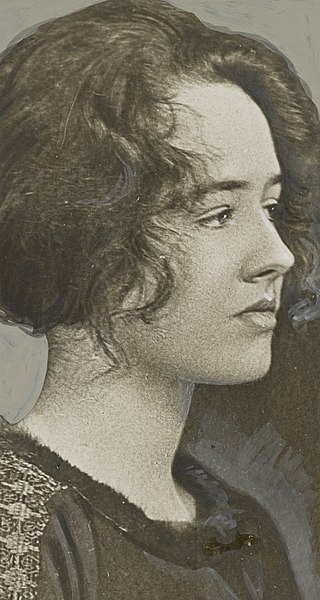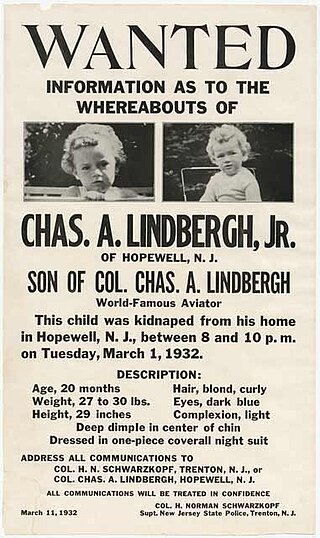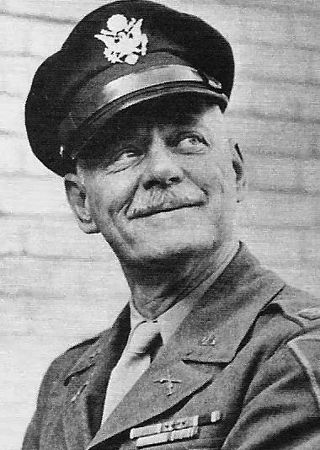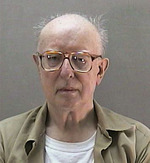Related Research Articles

Anne Spencer Morrow Lindbergh was an American writer and aviator. She was the wife of decorated pioneer aviator Charles Lindbergh, with whom she made many exploratory flights.

Bruno Richard Hauptmann was a German-born carpenter who was convicted of the abduction and murder of the 20-month-old son of aviator Charles Lindbergh and his wife Anne Morrow Lindbergh. The Lindbergh kidnapping became known as "The Crime of the Century". Both Hauptmann and his wife, Anna Hauptmann, proclaimed his innocence until he was executed in 1936 by electric chair at the Trenton State Prison.

On March 1, 1932, Charles Augustus Lindbergh Jr., the 20-month-old son of aviators Charles Lindbergh and Anne Morrow Lindbergh, was abducted from his crib in the upper floor of the Lindberghs' home, Highfields, in East Amwell, New Jersey, United States. On May 12, the child's corpse was discovered by a truck driver by the side of a nearby road.

Herbert Norman Schwarzkopf was the first superintendent of the New Jersey State Police. He is best known for his involvement in the Lindbergh kidnapping case. He was the father of General Norman Schwarzkopf Jr., the commander of all Coalition forces for Operation Desert Shield/Storm.

John Emil List was an American mass murderer and long-time fugitive. On November 9, 1971, he killed his wife, mother, and three children at their home in Westfield, New Jersey, and then disappeared; he had planned the murders so meticulously that nearly a month passed before anyone suspected that anything was amiss.

The Plot Against America is a novel by Philip Roth published in 2004. It is an alternative history in which Franklin D. Roosevelt is defeated in the presidential election of 1940 by Charles Lindbergh. The novel follows the fortunes of the Roth family during the Lindbergh presidency, as antisemitism becomes more acceptable in American life and Jewish-American families like the Roths are persecuted on various levels. The narrator and central character in the novel is the young Philip, and the care with which his confusion and terror are rendered makes the novel as much about the mysteries of growing up as about American politics. Roth based his novel on the isolationist ideas espoused by Lindbergh in real life as a spokesman for the America First Committee, and on his own experiences growing up in Newark, New Jersey. The novel received praise for the realism of its world and its treatment of topics such as antisemitism, trauma, and the perception of history. The novel depicts the Weequahic section of Newark which includes Weequahic High School from which Roth graduated. A miniseries adaptation of the novel aired on HBO in March 2020.

Along Came a Spider is a crime thriller novel, and the first novel in James Patterson's series about forensic psychologist Alex Cross. First published in 1993, its success has led to twenty six sequels as of 2021. It was adapted into a film of the same name in 2001, starring Morgan Freeman as Cross.

Following the historic Lindbergh kidnapping, the United States Congress passed a federal kidnapping statute—known as the Federal Kidnapping Act, 18 U.S.C. § 1201(a)(1) —which was intended to let federal authorities step in and pursue kidnappers once they had crossed state lines with their victim. The act became law in 1932. In 1934, the act was amended to provide exception for parents who abduct their own minor children and made a death sentence possible in cases where the victim was not released unharmed.

Saint Raymond's Cemetery is a Roman Catholic cemetery at 2600 Lafayette Avenue in the Throggs Neck and Schuylerville sections of the Bronx, New York City, United States. The cemetery is composed of two separate locations: the older section, and the newer section, both east of the Hutchinson River Parkway. The Bronx–Whitestone Bridge is located adjacent to the cemetery's newer section, while the neighboring Throgs Neck Bridge can be seen from a distance.

Arthur Koehler (1885–1967) was a chief wood technologist at the Forest Products Laboratory in Madison, Wisconsin, and was important in the development of wood forensics in the 1930s through his role in the investigation of the Lindbergh kidnapping. Koehler's particular research interest in the identification, cellular structure and growth of wood gave him the specific training and abilities necessary for the careful examination of the ladder which had been used by the abductor of Charles Lindbergh Jr., aged twenty months, and the tracing of the ladder to a company in McCormick, South Carolina. Koehler, from there, traced the wood of the ladder to a Bronx lumber yard.
David Theodore Wilentz was the Attorney General of New Jersey from 1934 to 1944. In 1935 he successfully prosecuted Bruno Hauptmann in the Lindbergh kidnapping trial. He was the father of Robert Wilentz, Chief Justice of the New Jersey Supreme Court from 1979 to 1996, as well as Norma Hess, wife of Leon Hess, founder of Hess Corporation and Warren Wilentz
Crime of the Century is a 1996 HBO television film directed by Mark Rydell. It presents a dramatization of the Lindbergh kidnapping of 1932. The film stars Stephen Rea as Bruno Hauptmann and Isabella Rossellini as his wife Anna.

The Hunterdon County Courthouse is an historic site located in Flemington, the county seat of Hunterdon County, New Jersey, United States, that is best known as the site of the 1935 "Trial of the Century" of Bruno Hauptmann and his conviction and sentence of death for his role in the Lindbergh kidnapping.
William Asher Stevens was an American jurist and Republican Party politician who served as President of the New Jersey Senate and New Jersey Attorney General. As Attorney General he conducted the early phase of the state's investigation into the Lindbergh kidnapping.

The following events occurred in March 1932:

Highfields was the home of Charles and Anne Lindbergh, the famous aviators. It was the location of the Lindbergh kidnapping, after which it was turned into a rehabilitation center. The home was added to the National Register of Historic Places in 1994.
The Lindbergh Kidnapping Case is a 1976 American television film dramatization of the Lindbergh kidnapping, directed by Buzz Kulik and starting Cliff DeYoung, Anthony Hopkins, Martin Balsam, Joseph Cotten, and Walter Pidgeon. It first aired on the NBC network on February 26, 1976.
Thomas Whitaker Trenchard was an American lawyer and a justice of the New Jersey Supreme Court between 1906 and 1941.
James Bailey Cash Jr. was a five-year-old child from Princeton, Florida who was smothered to death during his kidnapping by Franklin Pierce McCall in 1938.
Charles A. Appel, Jr., known as the founder of the Federal Bureau of Investigation (FBI) Laboratory, was an FBI Special Agent from 1924 through 1948. Assigned in 1929 by then-Bureau of Investigation Director J. Edgar Hoover to coordinate outside experts for forensic examinations, Appel became the Bureau’s one-man forensic laboratory in 1931. In November 1932, the FBI’s Technical Laboratory was formally established. In August 1933, he began processing evidence and testifying on handwriting, typewriting, fingerprints, ballistics, and chemicals submitted by U.S. police agencies. Appel was joined in late 1933 by Special Agent Samuel F. Pickering, a chemist, and in 1934, by Special Agents Ivan W. Conrad and Donald J. Parsons, also scientists. In September 1934, the FBI Laboratory came to widespread attention due to Appel’s identification of Bruno Hauptmann as the kidnapper of Charles Lindbergh Jr., from hand-written ransom demand notes.
References
- ↑ Zorn, Robert (2012). Cemetery John: The Undiscovered Mastermind Behind the Lindbergh Kidnapping. Abrams Press. ISBN 978-1590208564.